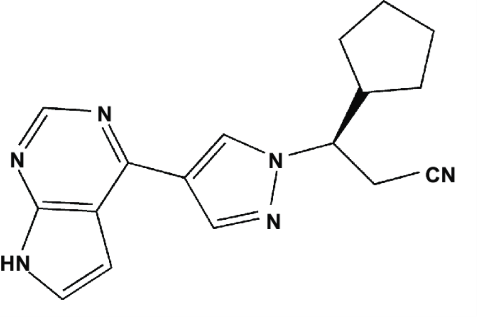Axinn IP Update: Federal Circuit Applies Lead Compound Analysis and Confirms Obviousness of Deuterated Derivatives of Ruxolitinib
August 29, 2023
By: Matthew Murphy
On August 22, 2023, the Federal Circuit affirmed an IPR Final Written Decision holding claims to deuterated derivatives of ruxolitinib unpatentable as obvious and rejected the patentee’s argument that a skilled artisan would not have been motivated to modify the undisputed lead compound based on prior art teaching the general benefits of deuteration. Sun Pharm. Indus., Inc. v. Incyte Corp., No. 2019-2011, Dkt. No. 117, at *15 (Fed. Cir. Aug. 22, 2023).
Ruxolitinib, shown below, is sold under the brand name Jakafi and is a small molecule inhibitor of JAK1/JAK2. FDA first approved ruxolitinib in 2011 to treat “intermediate or high-risk myelofibrosis.” Id. at *3.

Concert Pharmaceuticals, Inc. (later merged with Sun Pharmaceutical Industries, Inc.) held U.S. Patent No. 9,249,149 (“the ’149 patent”), which was directed to deuterated derivatives of ruxolitinib. Deuterium (H2 or D) is a stable isotope of hydrogen (H1 or H), and “[d]euteration involves replacing one or more hydrogen atoms of a drug with deuterium,” which can positively affect a drug’s pharmacokinetics without affecting its potency and selectivity. Id. at *3. The ’149 patent claimed ruxolitinib derivatives that replaced various hydrogen atoms on ruxolitinib’s cyclopentyl ring (i.e., the upper right-hand ring in the above structure) for deuterium atoms. See ’149 patent at claims 1–15.
Incyte Corporation petitioned for IPR, and ultimately, the PTAB held all claims unpatentable as obvious. See Incyte Corp. v. Concert Pharms., Inc., IPR2017-01256, Paper 119, at *51–52 (PTAB Apr. 8, 2019). The PTAB performed a lead compound analysis to assess obviousness, which involves asking (1) whether a POSA would select the prior art compound for further development and (2) whether a POSA would have motivation to modify that compound in a manner that leads to the claimed compound with a reasonable expectation of success. Id. at *20. Neither party disputed the former prong, and thus, the PTAB focused on the latter. In finding obviousness, the PTAB relied on three prior art references—one that disclosed ruxolitinib itself, one that disclosed that ruxolitinib’s cyclopentyl ring is a metabolic hotspot, and one that disclosed the benefits of deuteration in general (i.e., not specific to ruxolitinib). See Sun, No. 2019-2011, at *6–7.
On appeal, Sun argued that the PTAB erred as to motivation to modify ruxolitinib using deuteration, as to motivation to deuterate ruxolitinib’s cyclopentyl ring in particular, and as to reasonable expectation of success. In affirming the PTAB, the Federal Circuit recognized that the three prior art references, as well as expert testimony, provided substantial evidence that a POSA would have had “motivation to deuterate ruxolitinib, at its metabolic hotspots, in order [to achieve the benefits of deuteration].” Id. at *10–11 (emphasis added). The Federal Circuit also held that substantial evidence demonstrated that a POSA “would have reasonably expected . . . that deuterium modification could” result in improved pharmacokinetics, even if the precise benefit could not be predicted beforehand. Id. at *12–13 (emphasis added).
The Federal Circuit also rejected Sun’s argument that the claimed invention achieved an unexpected result. It agreed that any pharmacokinetic benefit achieved by deuteration was merely a “difference in degree” and “did not indicate a marked superiority.” Id. at *14.
Ultimately, this case highlights that obviousness challenges may be used to invalidate a compound patent at least where the prior art identifies an undisputed lead compound and teaches the benefit of a proposed modification, even generally, with a reasonable expectation of success.
To subscribe to our publications, click here.
Featured Insights
Featured Insights
ACI 12th Annual Summit for Women Leaders in Life Sciences Law
Speaking Engagement
Intellectual Property
National LGBTQ+ Bar Association Lavender Law Conference and Career Fair 2025
Sponsorship
National Bar Association 100th Annual Convention and Exhibits
Sponsorship
Antitrust
Keeping Pace: Updates in Cartel Enforcement
Webinar
Antitrust
New Incentives, New Rewards: What You Need to Know About the Antitrust Division’s First-Ever Whistleblower Rewards Program
Axinn Viewpoints
Antitrust
Informa Antitrust Midwest
Speaking Engagement
GCR Live: Law Leaders Europe 2025
Speaking Engagement
Antitrust
How I Made Partner: 'Show Up and Build Rapport With Colleagues and Clients,' Says Michael O'Mara of Axinn Veltrop & Harkrider
Media Mentions
Antitrust
Axinn Counsel Rebecca Clegg Named 2025 MCCA Rising Star
Awards & Recognitions
Intellectual Property
Chambers Merger Control 2025 Guide
Byline Articles
Antitrust

